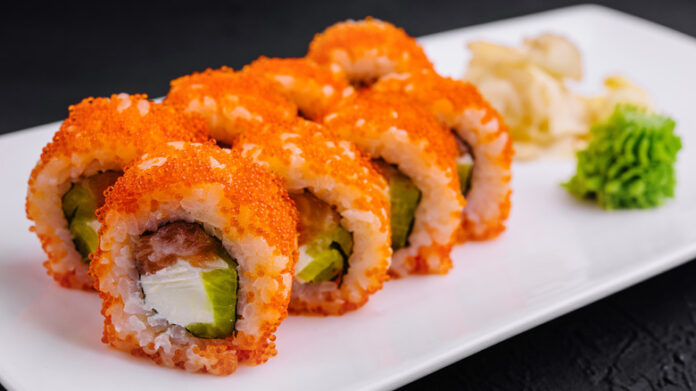Introduction
Masago, or small, bright orange roe of capelin fish (Mallotus villosus), is a very widely used spice internationally—most notably in Japanese food’s sushi rolls, sashimi garnishes, and Japanese food seafood salads. It is prized not just for its crunchy texture and pale but rich flavor but also as an ornamentally garnishing ingredient and as a nutrient-rich ingredient of golden cultural heritage with many different culinary applications.
What is Masago?
Masago are cookable capelin eggs, small forage fish that inhabit cold Arctic and North Atlantic oceans. Although tobiko (flying fish roe) is typically drawn in comparisons with masago, the latter is more delicate, less crunchy, and sweeter to consume.
Flavor Profile and Culinary Appeal
Masago is light and sweet with a brininess to it which is suitable for both raw and prepared seafood. It provides a textural contrast in the form of its light crunch, and its pale color is also rendered in the visual composition of plates.
Nutritional Value of Masago
Beautiful not only to look at, masago is also very rich in nutrients. A 1-tablespoon (16-gram) serving of masago yields:
- Calories: ~40
- Protein: 3–4 grams
- Fat: 2–3 grams
- Omega-3 Fatty Acids: 300–400 mg
- Vitamin B12: ~50% of the daily value
- Selenium: ~10% of the daily value
The small eggs are rich in omega-3 fatty acids, which are vital for the heart, and also a source of B vitamins and trace minerals.
Health Benefits of Masago
1. Supports Heart Health
Because of its high omega-3 nutritional value, masago can ward off inflammation, lower blood pressure, and promote cardiovascular wellbeing.
2. High in Antioxidants
Masago contains such a level of selenium that it protects cells from oxidative harm and keeps the immune system in top working order.
3. Boosts Energy
The very high vitamin B12 content is responsible for energy metabolism, brain function, and red blood cell formation.
4. Great Source of Lean Protein
Low calorie but full of protein, masa go is the perfect ingredient for the person requiring nutrient-dense, calorie-conscious meals.
Possible Health Concerns
Healthy for the general public, there are however concerns to be aware of:
High in Sodium: Typically salted when manufactured, masa go makes a significant contribution to daily sodium intake.
Allergens: Being a fish product, it will react with sensitive individuals.
Cholesterol: Has medium cholesterol content, hence people with some diet limitations can possibly consume in moderation.
Mas go Use in Domestic Preparations
1. Sushi and Sashimi
Masa go serves as an official garnish for California rolls, dragon rolls, and rainbow rolls. It’s applied on the top or layered inside to offer a burst of flavor.
2. Masa go Mayo
Rich mayonnaise sauce with masa go, and occasionally with sriracha, great to drizzle on poke bowls or fried seafood.
3. Salads
Masa go is employed to provide color and texture to seaweed salads, cucumber salads, and seafood salads in Japanese cuisine and fusion cuisine.
4. Rice and Noodle Recipes
Masa go can be employed to provide a light seafood taste to fried rice, soba noodles, or pasta.
5. Garnishes
Used to garnish omelets, soups, or canapés, masaago provides a burst of color and a soft umami taste.
Masaago in Global Cuisine
While of Japanese origin, masaago has dominated Nordic, Hawaiian, and contemporary fusion cuisine. Capelin roe is sometimes smoked or topped on Nordic foods as a bread topping. It adds crunch texture and pops of color to Hawaiian poke bowls.
Processing of Masaago
Masa go processing primarily consists of:
Harvesting the Capelin: Females are harvested when they are spawning condition and have the roe in optimum maturity.
- Roe Processing: Gently treated and washed.
- Salting and Seasoning: For freshness and added flavoring.
- Coloring: Aesthetically colored using bright dyes in sushi bars.
- Packaging: Frozen or chilled packed for quality retention.
Storage and Shelf Life
To maintain freshness:
- Refrigeration: Store the unopened masagao at 0–4°C (32–39°F).
- Freezing: Can be frozen for storage for as long as 6 months without loss of a lot of texture.
- After Opening: Best consumed within 3–4 days when stored in the refrigerator.
- MASAaGO is kept safely to help keep its flavor, color, and nutrients.
Where to Purchase Masaago
Masaago can be easily procured at:
Japanese food stores
Gourmet food stores
Specialty fish stores
Online gourmet food stores
When purchasing, check bright and even color, no off-odor, and proper packaging to guarantee freshness.
Sustainability Problems
Capelin is susceptible to overfishing and climate change. Sustainable sourcing will ensure consistent supply of masago. Source from Marine Stewardship Council (MSC) certified producers.
Cooking Tips for the Utilization of Masago
Do Not Use High Heat: Masago is delicate—add towards the end of cooking to maintain texture.
Balance Flavors: Serve with weak or flavorless ingredients so the flavor can be highlighted.
Gourmet Applications: Use as top deviled eggs, cream cheese dips, or sprinkle on pizza as a topping for added gourmet flavor.
Conclusion
Masago is not merely a topping for sushi—it’s a healthy, versatile, gorgeous ingredient that brings sophistication to any or all of the dishes. Mild in flavor, satiating in texture, and full of nutrients, masago trumps a place in both traditional and modern cuisine. By discovering where it comes from, how it is used, and how to keep it, we can most enjoy and use this luxury in our arsenal.
